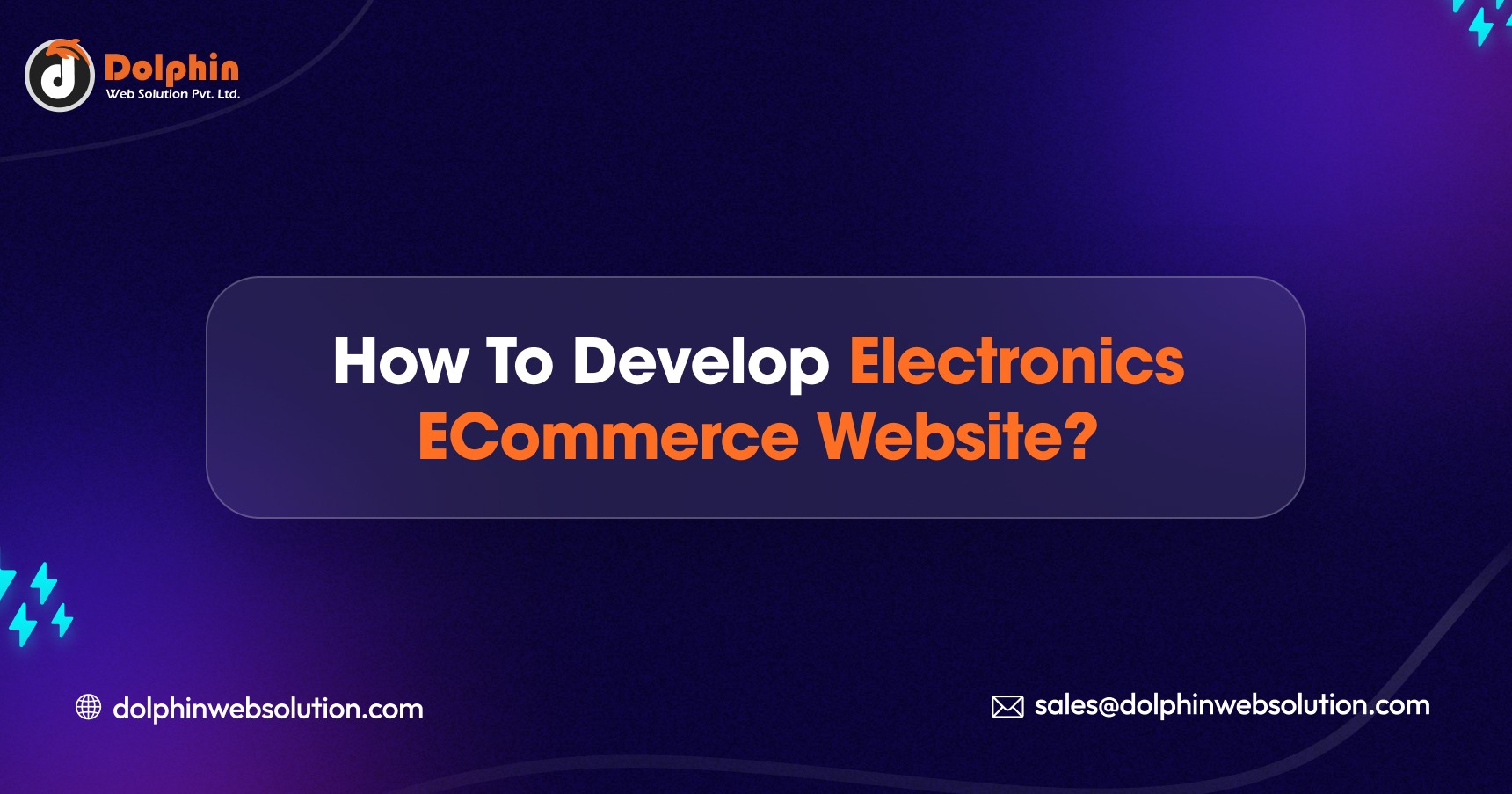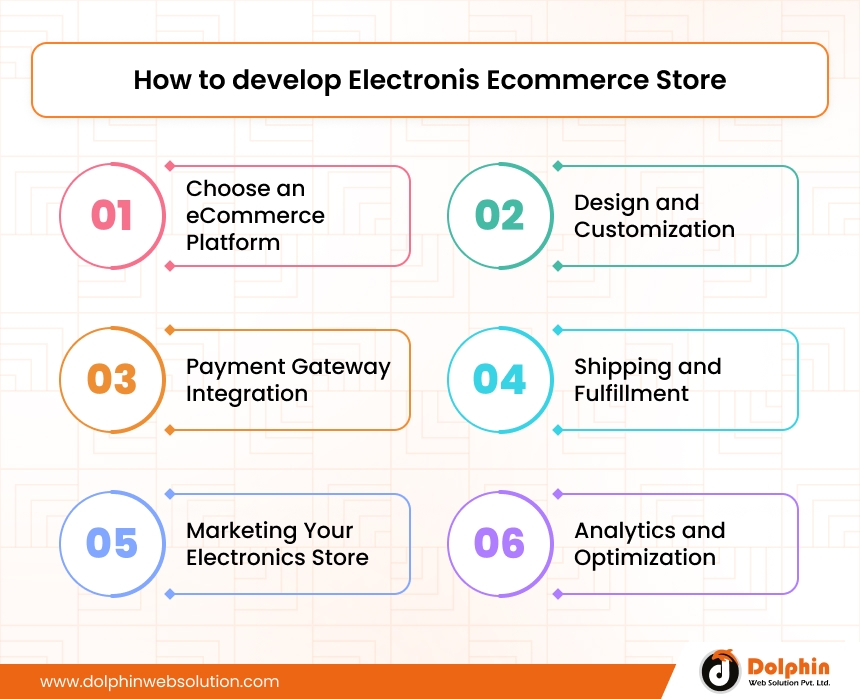How to Develop Electronics eCommerce Website?

Table of Contents
Summary :
The eCommerce market has penetrated almost every consumer goods industry, including electronics and electronic appliances. By 2022, nearly 2.3 billion people had made online purchases, a significant jump considering it was not a household concept even a couple of decades ago. The number will only increase in future. If you want to be one of the stores to buy from, you would need an end-to-end, all-equipped eCommerce website.
There are multiple reasons why online stores are slowly replacing physical stores in almost every possible industry – convenience is perhaps at the top of the list. Wouldn’t you prefer to browse and place orders while sitting on your couch or even using the toilet if that meant avoiding the commute and the crowd?
Among all the things bought and sold online, electronics are one of the most popular commodities. It is understandable as they make excellent items for gifting – both personal and corporate – on top of individual purchases.
Here are some statistics: Of the $6.3 trillion sales generated by the retail eCommerce market worldwide in 2023, approximately $344 billion came from electronics, making it among the most profitable e-commerce niches.
Want a share of the pie for yourself? Here is the essence of the eCommerce electronics market and how to build a successful eCommerce website.
How to Develop Electronics Ecommerce Store

1. Choose an eCommerce Platform
Let us start with choosing the right ideal eCommerce platform. Some of the popular eCommerce platforms that you can consider are:
- Shopify
- WooCommerce
- Magento
- BigCommerce
When choosing an eCommerce platform, its features and functionalities match your website requirements. The best eCommerce frameworks can help you with all, including:
- Managing Inventory
- Generating Product Descriptions
- Fulfilling Orders
- Tracking Analytics
- Integrating Sales Channels
Following are the considerations in choosing a platform
Budget: The cost of an eCommerce platform is an essential consideration. Consider all costs, including upfront as well as ongoing costs, such as
- Transaction Fees
- Monthly Fees
- Plugins
- Add-on features
- Customizations and Plugins
Ease of Use: Your eCommerce platform should be easy to set up and user-friendly. Wasting your resources on a highly-complicated website won’t be fruitful. ECommerce platforms can be operated even without much programming skills or technical knowledge.
Scalability: Choosing an eCommerce platform that grows with your eCommerce business. It should be able to handle both increased traffic and functionality needs. A scalable platform will be able to handle it all be it:
- Increased Website Traffic
- Traffic
- Usage
- Sales
Security: How to protect the personal and financial data of your customers? Well, focus on website security. Your site’s payment processing system should be reliable and secure. It should be PCI-compliant and support SSL encryption.
2. Design and Customization
The design of your website should be given considerable thought, as users may refrain from purchasing from your online electronics store if it’s not well-structured and navigable.
Easy Navigation: Navigation plays an essential role in making your website successful. Poor navigation can result in cart abandonment and frustration, causing users to leave your site and opt for your competitors. An intuitive navigation enhances user satisfaction and increases the chances of repeat visits and purchases in the future.
Responsiveness: Develop a mobile-friendly layout that can easily adapt to various resolutions and screen sizes. You can also optimize the site’s navigation for touch interactions by leveraging larger menus or buttons that expand on tapping. Ensure your website delivers seamless navigation across devices and an unparalleled user experience. Users should be able to access the desired information on all devices effortlessly.
Customization: Customizing your website is essential as it will represent your brand accurately and enable your website to stand out. A customized website that resonates with your brand’s image can boost user engagement and experience. Customization will showcase the unique brand identity, act as a competitor, and communicate your message effectively.
Use of High-Quality Media: People don’t buy items like iPhones or other expensive gadgets daily. They would like to review the product in-depth and understand how it would look and feel. Your website must have high-quality product images, videos, and descriptions. This will showcase your electronic products in the best possible way and help your users make an informed decision.
3. Essential Features for an Electronics eCommerce Website
Here are some of the essential features that you must integrate into your electronics eCommerce web:

Product Catalog
Your product catalogue should be user-friendly and enable quick product searches by users on your website. An easily browsable product catalogue would help users discover electronics available on your site and which best suits their requirements. Include sections for exclusive items, best-sellers, top savers, and related items.
Shopping Cart and Checkout
Your shopping cart should have a simple visual design, display company branding, and integrate prominent checkout buttons. You can also notify customers about the products they have added to their cart but never purchased. Also, an easy-to-use, optimized checkout is an essential eCommerce feature as it will lower your cart abandonment rate and keep your users engaged.
Multiple Payment Options
A credible eCommerce electronics store should feature secure payment options. Offering multiple modes of payment will make your website more accessible to all your customers.
Search and Navigation
Search, filtering, and navigation are essential features of any eCommerce website. Search features enable users to find products on your site effortlessly. Filters will enable users to narrow down the product list and focus on electronic products they are interested in. Also, your website should be easily navigable on all devices.
4. Payment Gateway Integration
Discover the vital role of payment gateway integration on an eCommerce website. Let’s dive in!
Secure Payment Gateways: Safely process all credit card transactions using a secure gateway linked directly to your provider. Your users trust you with their financial and personal information. Hackers can access these highly sensitive customer data if you don’t integrate secure payment gateways. Customers will abandon their shopping carts if they feel unsafe while processing the transaction. From increased bounce rates to a negative brand image, your electronics online store will suffer significantly if you don’t use secure payment gateways.
Dynamic Payment Options: There are multiple payment gateway options, such as PayPal, Authorize.Net, Stripe, etc. The cost and process of integrating these options would vary. These payment gateway options come with unparalleled fraud protection services, customizable integrations, easy-to-use checkout features, and other subscription-based additional functionalities.
PCI Compliance: To prevent fraud related to card data theft, the leading card networks have teamed up to form the PCI Council. This council has established a set of security measures to protect customers’ sensitive financial data. Make sure your payment gateway is PCI-compliant to safeguard your customers and win their trust.
Supports Multiple Payment Methods: Your website should support multiple payment methods such as mobile payments (Google Pay, etc.), credit cards, cash on delivery, etc. When you offer multiple payment methods, you will experience a maximized conversion rate, improved customer loyalty, minimized abandoned carts, improved customer experience, and better brand perception. This will also make the checkout process more effortless.
5. Shipping and Fulfillment
Shipping and order fulfillment are related to your inventory management system and can greatly impact your sales and brand image.
Shipping Rates: Many brands offer customers fast, free shipping options to improve customer loyalty and boost sales. When determining shipping rates, it’s important to take into account various factors such as:
- Cost of Shipping Supplies
- Courier Services
- Export Fees
- Employee Wages
Offer Multiple Shipping Options: A well-functioning eCommerce shipping feature is crucial for boosting sales and customer retention. Invest in the feature to ensure prompt delivery of orders.
Connect Inventory with Orders: When it comes to fulfilling orders, the process typically consists of storing your products, packing them when a customer makes an online purchase, and finally shipping them off to your eager customers. However, sometimes the process can get slightly intimidating, especially when too many orders come in. There is no need to worry. You can easily outsource inventory handling to third-party services, ensuring hassle-free, timely delivery.
6. Marketing Your Electronics Store
Even if you tick all the boxes while building your online electronics store, it will not reap any results unless you market it right. In a world where the customer perception of your brand primarily runs businesses, you must invest the right amount of money and effort in promoting your website. Here are your best bets:
SEO Optimization: To allow your potential customers to discover your website easily, your first and foremost goal should be improving the search engine ranking with the help of better SEO implementation. Focus on making the website user-friendly, embedding high-quality images and videos, providing information-rich and original text content, better site navigation, and other tactics to optimize your SEO score organically. Avoid Black Hat SEO tricks like keyword stuffing, blog spamming, snippet abuse, etc.
Social Media: In our digital age, having a strong presence on social media is crucial for businesses. Since 71% of adults actively use social media, social media allows you to tap into a large section of the target audience in one place. Keep your viewers engaged with cleverly curated content tailored for each platform – Facebook, Snapchat, Twitter, Instagram, etc. Behind-the-scenes footage, video testimonials, infographics, and the occasional use of a recently viral meme do wonders for social media marketing.
Email Marketing: Email marketing is a must-have strategy for any marketing plan. By keeping your subscribers in the loop with new product releases, discounts, and other updates, you can earn strong customer loyalty and increase traffic, ultimately driving more sales.
Promotions and Sales: If you are completely wrong, you feel that discounts and special offers will leave you broke. Freebies, discounts, and offers are great promotion techniques that can significantly boost your sales by making users believe they are saving more. Limited-time sales will create an urgency in customers to shop from your site immediately instead of saving it in your cart for later. Offer private sales to registered users, give more discounts to regular customers, and promote “buy one, get two” options to lure your customers.
Affiliate Marketing: Besides organic marketing, you can increase your affiliate marketing ads to boost your SERP rankings and conversions. These marketing tools can offer instant results if you use them correctly.
7. Analytics and Optimization
Without the right analytics tools, you won’t be able to analyze important customer data, which can slow down your site’s growth.
Use Analytics to Study Traffic and Buying Behavior: Metrics like bounce rates, page views, user flow, and conversion rates should be analyzed to understand user behavior. Multiple analytics tools will help you study traffic and track users’ buying behavior. This will provide valuable insights and allow you to improve your customer experience.
Funnels to Reduce Cart Abandonment: Use a funnel analysis tool to fully understand your shoppers’ checkout journey and quickly figure out why they abandoned their cart. This will allow you to remove friction points from your site’s checkout process and react seamlessly to high-priority problems.
A/B Testing for Optimization: In eCommerce website development, A/B testing should be given the attention it deserves. It allows strategic decision-making backed by data to boost clicks, awareness, and conversions.
Cost to To Develop An Electronics eCommerce Website
- Basic Site: $2,000 – $5,000 A basic, simple site with minimal product customization, standard pages and payment integration. Good for new or small electronics businesses to establish an online presence.
- Mid-Level Site: $5,000 – $10,000 A more robust site with customized product display features, additional pages, targeted marketing capabilities, and optimized for scalability. Has more advanced features like customization and security.
- High-End Site: $10,000 – $50,000+ A complex, enterprise-level site with very customized designs and layouts, complex product configuration options, custom security and fraud detection modules, integrated inventory management and order processing. Robust analytics and reporting.
Conclusion
Building an eCommerce site takes work but is worth the investment if you use the right tools and functionalities. An electronic eCommerce website can significantly expand your customer reach online and generate more sales. The first step of eCommerce development is to choose an ideal platform and integrate essential features such as mobile responsiveness, secure payment gateways, multiple shipping options, etc. Follow our guide to build a successful, scalable online electronics store. If you want to develop an electronic ecommerce website for your business then connect with the Dolphin Web Solution team.

Hello!
Click one of our contacts below to chat on WhatsApp


